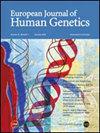扩大ReNU综合征的突变谱:对5'茎环变异的见解。
IF 3.7
2区 生物学
Q2 BIOCHEMISTRY & MOLECULAR BIOLOGY
引用次数: 0
摘要
编码小核RNA (snRNA) U4的RNU4-2的窄谱杂合变异体是ReNU综合征的基础,ReNU综合征是一种神经发育障碍(NDD),其特征是中度至重度发育迟缓(DD)、智力残疾(ID)、独特的面部完形和多系统受累。据报道,致病变异主要发生在一个18 nt的关键区域,该区域有助于稳定U4/U6 snRNA双工和正确的剪接体组装。通过对190例分子原因不明的NDD病例进行全基因组测序再分析和靶向直接测序,我们报告了5例携带致病性/推定致病性RNU4-2变异的患者(2.6%)。3个个体携带复发致病性n.64_65insT变异,而2个个体在5'茎环区域内携带私人/罕见的母系遗传变异(n.30 A > T和n.43_44insT)。深度临床表型证实了所有个体的同质特征星座,具有全局DD, ID,脑畸形和可识别的面部格式塔代表核心发现。基于结构同源性模型和现有的cro - em数据,预测n.30 A > T和n.43_44insT会破坏剪接体功能的关键分子内和分子间相互作用。我们的发现扩大了ReNU综合征的突变谱,并证实了5'茎环是RNU4-2的第二个突变热点。我们提出,一个更复杂的遗传学可能是导致疾病的RNU4-2变体子集从一个明显未受影响的父母遗传的基础。我们预计,尽管进行了广泛的基因组检测,但在未分类的NDD患者中,致病性RNU4-2变异的比例相对较高,并提出了一套面部格式塔核心特征作为临床筛选工具,优先考虑RNU4-2分析的患者。本文章由计算机程序翻译,如有差异,请以英文原文为准。

Expanding the mutational spectrum of ReNU syndrome: insights into 5’ Stem-loop variants
A narrow spectrum of heterozygous variants in RNU4-2, encoding the small nuclear RNA (snRNA) U4, underlies ReNU syndrome, a neurodevelopmental disorder (NDD) characterized by moderate to severe developmental delay (DD), intellectual disability (ID), a distinctive facial gestalt, and multisystem involvement. Pathogenic variants have primarily been reported within an 18-nt critical region contributing to stabilizing the U4/U6 snRNA duplex and proper spliceosome assembly. By combining whole genome sequencing reanalysis and targeted direct sequencing in 190 molecularly unexplained NDD cases, we report on five affected individuals carrying pathogenic/putative pathogenic RNU4-2 variants (2.6%). Three individuals harbored the recurrent pathogenic n.64_65insT variant, while two were heterozygous for private/rare maternally inherited variants (n.30 A > T and n.43_44insT) within the 5’ Stem-loop region. Deep clinical phenotyping confirmed a homogeneous constellation of features in all individuals, with global DD, ID, brain malformations, and a recognizable facial gestalt representing core findings. Based on structural homology models and available cryo-EM data, n.30 A > T and n.43_44insT were predicted to disrupt key intra- and inter-molecular interactions critical for spliceosome function. Our findings expand the mutational spectrum of ReNU syndrome, and confirm the 5’ Stem-loop as a second mutational hotspot in RNU4-2. We propose that a more complex genetics likely underlies the inheritance of a subset of disease-causing RNU4-2 variants from an apparently unaffected parent. We anticipate a relatively high proportion of pathogenic RNU4-2 variants among individuals with unclassified NDD despite extensive genomic testing, and propose a set of facial gestalt core features as a clinical screening tool to prioritize patients for RNU4-2 analysis.
求助全文
通过发布文献求助,成功后即可免费获取论文全文。
去求助
来源期刊

European Journal of Human Genetics
生物-生化与分子生物学
CiteScore
9.90
自引率
5.80%
发文量
216
审稿时长
2 months
期刊介绍:
The European Journal of Human Genetics is the official journal of the European Society of Human Genetics, publishing high-quality, original research papers, short reports and reviews in the rapidly expanding field of human genetics and genomics. It covers molecular, clinical and cytogenetics, interfacing between advanced biomedical research and the clinician, and bridging the great diversity of facilities, resources and viewpoints in the genetics community.
Key areas include:
-Monogenic and multifactorial disorders
-Development and malformation
-Hereditary cancer
-Medical Genomics
-Gene mapping and functional studies
-Genotype-phenotype correlations
-Genetic variation and genome diversity
-Statistical and computational genetics
-Bioinformatics
-Advances in diagnostics
-Therapy and prevention
-Animal models
-Genetic services
-Community genetics
 求助内容:
求助内容: 应助结果提醒方式:
应助结果提醒方式:


